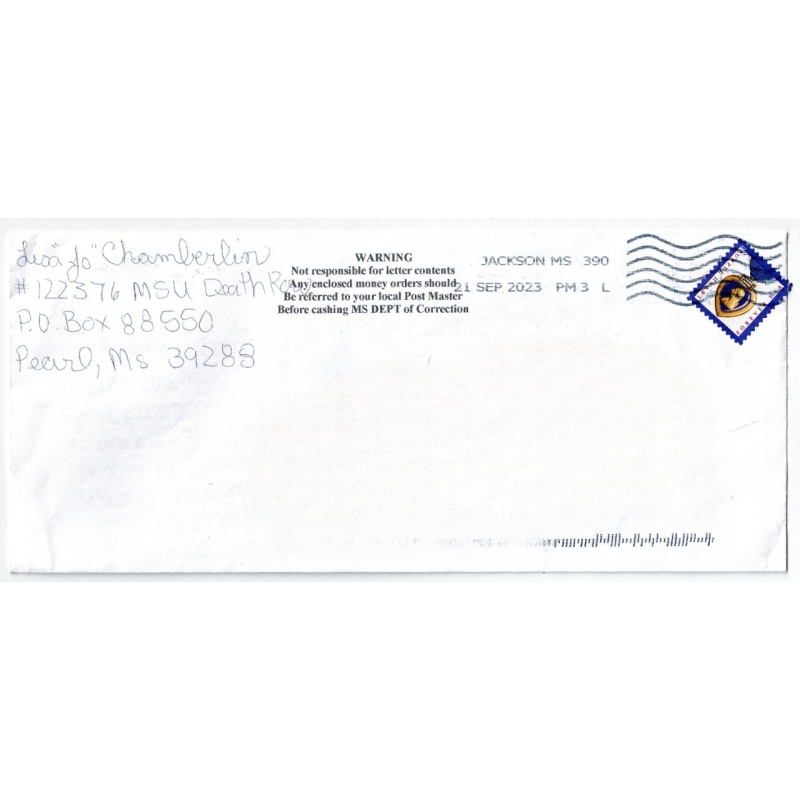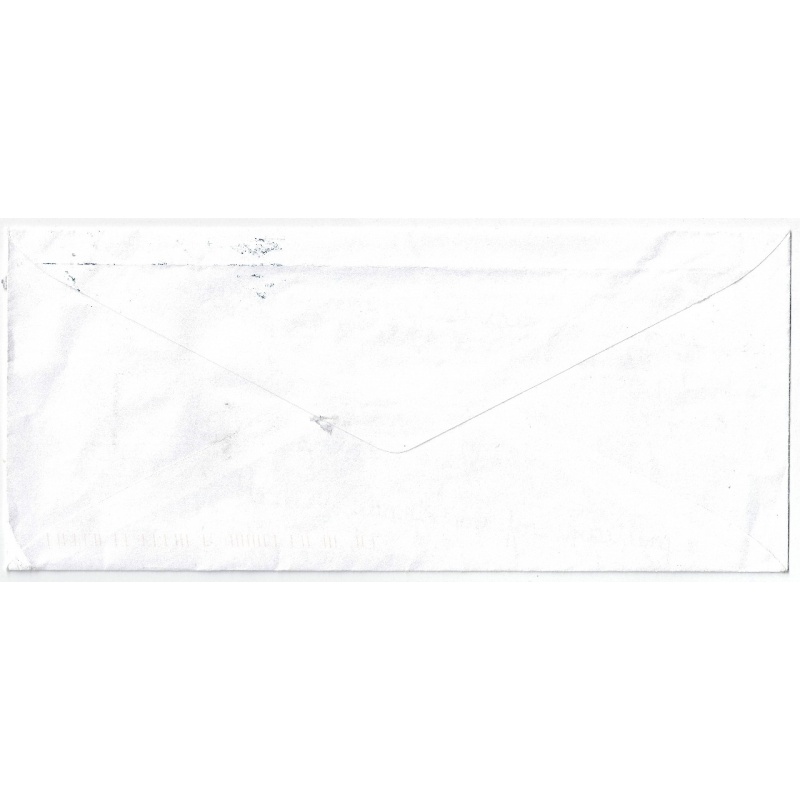LISA JO CHAMBERLIN | Mississippi Death Row | "She said she wasn't scared of the killings," a cellmate testified. "She was really upset because she said they should have disposed of the bodies better, like feeding them to the hogs." | ALS
LongfellowSerenade 27
Lisa Jo Chamberlin is sitting on Mississippi death row for the murders of two people. According to court documents Lisa Jo Chamberlin and her boyfriend Roger Gillett were manufacturing meth and believed that the female victim was going to tell the police about their drug dealing ways decided to kill her. When they arrived at her home they also found her boyfriend so the pair decided to kill them both and dispose of the bodies.
When people saw Lisa Jo Chamberlin and Roger Gillett driving around in the victims vehicle while dealing meth they reported it to the police who would investigate and soon the pair were charged with murder.
$20.00
- Postage
-
$0.00 to United States
Standard Shipping
Get Additional Rates
- Select Country
- Zip/Post Code
- Quantity
Description
Lisa Jo Chamberlin. Autographed Letter, Signed. Handwritten, Commercial #10 (4.125 × 9.5 envelope). Jackson, MS. Pmk: September 21, 2023. Content unknown. SEALED.
The investigation into this gruesome double murder began when Kansas authorities received a report that the defendant Lisa Jo Chamberlin and her boyfriend and co-defendant, Roger Gillett, were in possession of a stolen vehicle and were manufacturing methamphetamine at the Gillett farm in Russell County, Kansas.
Based on the information received, Kansas Bureau of Investigation (KBI) Officer Matthew Lyon obtained two search warrants. One warrant authorized the search of 606 North Ash, where Gillett and Chamberlin were staying, and the second warrant authorized the search of the Gillett farm.
On March 29, 2004, at 3:45 p.m., officers began a search at 606 North Ash. Lyon and other KBI officers participated in the search. The search was completed at 5:05 p.m. KBI officers found Gillett and Chamberlin, as well as methamphetamine and other drug paraphernalia, at 606 North Ash. KBI officers arrested Gillett and Chamberlin that day. Chamberlin was detained at the Russell County Jail.
At approximately 5:13 p.m. on March 29, Lyon attempted to interview Chamberlin. After Lyon read Chamberlin her Miranda rights, Chamberlin told Lyon that she did not want to answer any questions. The interview ended at approximately 5:20 p.m. Only identifying questions were asked and answered in that interview.
Chamberlin was charged with a number of drug-related offenses. Meanwhile, at approximately 5:15 p.m., other officers began to search the Gillett farm. At the farm, the first officers to arrive discovered a white Dodge Dakota pickup truck with Mississippi plates parked in a metal shed and a white freezer that was taped shut with duct tape and plugged in inside a wooden granary.
Upon opening the freezer, the officers discovered a dismembered body, later identified as Vernon Hullett, and a black plastic trash bag which contained severed body parts. The officers secured the premises while they sought and obtained a third search warrant. Armed with this third search warrant, which authorized the officers to search for evidence in connection with the murder investigation, the officers returned to the Gillett farm, pulled the male body out of the freezer and discovered another body frozen in a liquid in the bottom of the freezer. The officers thawed the contents of the freezer and extracted a second body, later identified as Linda Heintzelman. The search at the farm was completed the next day, March 30, at 5:22 p.m.
On the evening of March 29, Officer Lyon received a call from the Russell County Sheriff advising him that two bodies had been found at the Gillett farm. Officers conducted three interviews with Chamberlin during the course of the day on March 30.
At the end of Chamberlin’s last interview on the afternoon on March 30, she agreed to show KBI Officer Delbert Hawel the location where she and Gillett had dumped evidence at the landfill in Russell. At approximately 8:00 p.m., KBI Officer Max Barrett, Hawel, and Chamberlin rode to the Russell County dump, and Chamberlin indicated where some of the physical evidence from the murders had been deposited. The landfill was secured until it could be searched. Barrett testified that later that evening, after returning to the sheriff’s office, he was contacted by one of the corrections officers who told him that Chamberlin wanted to talk to a KBI agent. Since the KBI agents had left for the evening, Chamberlin indicated that she would talk with Barrett. Barrett testified that when he spoke with Chamberlin she expressed her desire to talk to one of the agents, and he relayed her request to an agent.
The next day, March 31, officers returned to the dump and recovered seven plastic trash bags, containing, among other things, one of Hullett’s work shirts, pants with Hullett’s name on them, a pillow heavily stained with blood, a camera, a purse containing identification which apparently belonged to Heintzelman, a wallet and identification that belonged to Hullett, a Hattiesburg, Mississippi, phone book, and the cardboard center of a roll of duct tape. Barrett packaged the evidence and transferred it to Hattiesburg Police Officer Rusty Keyes.
During the three interviews on March 30 and the interview on the morning of March 31, Lisa Jo Chamberlin explained her relationship with Gillett and her participation in the robbery and murders of Hullett and Heintzelman. Chamberlin met Gillett in Oregon, where she was born and raised. They lived together for a brief time in Oregon before they moved to Russell, Kansas, where they lived with some of Gillett’s relatives. Around the beginning of March, Chamberlin and Gillett drove from Russell County, Kansas, to Hattiesburg, Mississippi, where they stayed with Gillett’s cousin, Vernon Hullett, and his live-in girlfriend, Linda Heintzelman. On March 6, shortly after arriving in Hattiesburg, Gillett and Chamberlin wrecked their car while following Hullett and Heintzelman in Heintzelman’s pickup truck on Highway 49. According to Chamberlin, Heintzelman changed lanes too closely in front of their vehicle, causing them to run into the rear of Heintzelman’s truck. Gillett’s car was badly damaged, but Heintzelman’s truck sustained only minor damage.
According to Chamberlin, Heintzelman promised to report the accident as a claim against her insurance and then divide the insurance proceeds with Chamberlin and Gillett. Heintzelman never submitted the accident report to her insurance company.
Chamberlin told KBI officers that on an unknown date in March 2004, she, Gillett, Hullett, and Heintzelman were all at Hullett’s residence. Hullett and Heintzelman suggested that Gillett and Chamberlin get their own place to live. Chamberlin agreed, but Gillett wanted to stay at Hullett’s. Chamberlin and Gillett argued about moving. Unable to drive her car in its damaged condition, Chamberlin left on foot and returned that evening to find Gillett standing on the front porch smoking a cigarette.
When Chamberlin and Gillett entered the house, Gillett became violent with Heintzelman, accusing her of not being truthful about reporting the accident to her insurance company. Gillett instructed Chamberlin to get his gun from under the mattress in the bedroom. Chamberlin complied. Chamberlin and Gillett cut the telephone wires so that Hullett and Heintzelman could not call the police. Gillett fired one round inside the house to scare Hullett and Heintzelman.
Gillett punched and hit Hullett several times in an attempt to get the combination to Hullett’s safe. Upon discovering that all the beer in the house had been consumed, Chamberlin left again to get more beer. When Chamberlin returned, Heintzelman was bent over the safe and was not wearing any pants. Chamberlin inquired as to whether Gillett had raped Heintzelman. Gillett explained that he wanted to “break her,” so he made her take her clothes off and used a beer bottle to rape her. Still unsuccessful in opening the safe, Chamberlin became impatient and told Gillett something similar to “let’s just kill them and get out of here.”
According to Chamberlin, Gillett bashed Hullett in the head with a hammer while Hullett was sitting in a chair in the living room. Gillett also slashed Hullett’s throat. Chamberlin went out of the house and came back in a number of times over several hours while Heintzelman was lying on the floor, injured but “still breathing.” Eventually, Chamberlin suggested that they smother Heintzelman. Chamberlin and Gillett worked together to bind Heintzelman’s hands behind her back so that she could not struggle with them. Gillett lifted Heintzelman’s head, and Chamberlin placed a bag over it. Chamberlin told the officers that she was unable to complete the asphyxiation of Heintzelman and went outside. She said that Heintzelman was still breathing when she went outside, but when she returned, Heintzelman was dead.
Chamberlin told the officers that she assisted in cleaning up the murder scene. She helped move the bodies to the bathroom, where Gillett cut off Hullett’s head and arms and she held garbage bags open while Gillett placed Hullett’s arms inside the bags. Chamberlin described how she assisted in loading Heintzelman’s body and then Hullett’s body, along with the black trash bag, into the freezer and how she taped the freezer shut as Gillett stood on top of the freezer to hold it closed. Chamberlin and Gillett took Hullett’s pickup truck and transported the freezer containing the two bodies on the back of that truck from Hullett’s house to Kansas. After arriving in Kansas, they unloaded the freezer and plugged it in at the Gillett farm. She indicated that they took the items they transported from Hullett’s house and disposed of them at the Russell dump. Also, she agreed to cook some methamphetamine for five hundred dollars because they needed money. She described how they discarded the trash from making methamphetamine at the public swimming pool and how on the next day she and Gillett were arrested.
During trial, Dr. Donald Pojman, who performed the autopsies on Hullett and Heintzelman, testified that the cause of Heintzelman’s death was from “[s]harp-force injuries of the torso and the neck,” “blunt-force injuries of the head,” and “asphyxiation,” and that the cause of Hullett’s death was blunt-force injuries to the left side of the head.
VIDEO: The Disturbing Case Of Lisa Jo Chamberlin | https://youtu.be/M1ZK8GZeYgo
Archiving Protocol:
• Handled with White Gloves ab initio
• Photo Pages/Sheet Protectors: Heavyweight Clear Sheet Protectors, Acid Free & Archival Safe, 8.5 × 11, Top Load
• White Backing Board—Acid Free
Shipping/Packaging: Rigid Mailer 9.5 × 12.5. White, self seal, stay flat, kraft cardboard, no bend. Each rigid mailer is made of heavy cardboard, which has strong resistance to bending and tearing. Thicker that the USPS mailers. Shipping cost never more than it absolutely has to be to get it from me to you.
Payments & Returns
- Payment Methods
- PayPal, Money Order
Postage & Shipping
- Item Location
- 54911, Wisconsin, United States
- Ships To
- Worldwide
- Pick-ups
- No pick-ups
- Returns Accepted
- No






